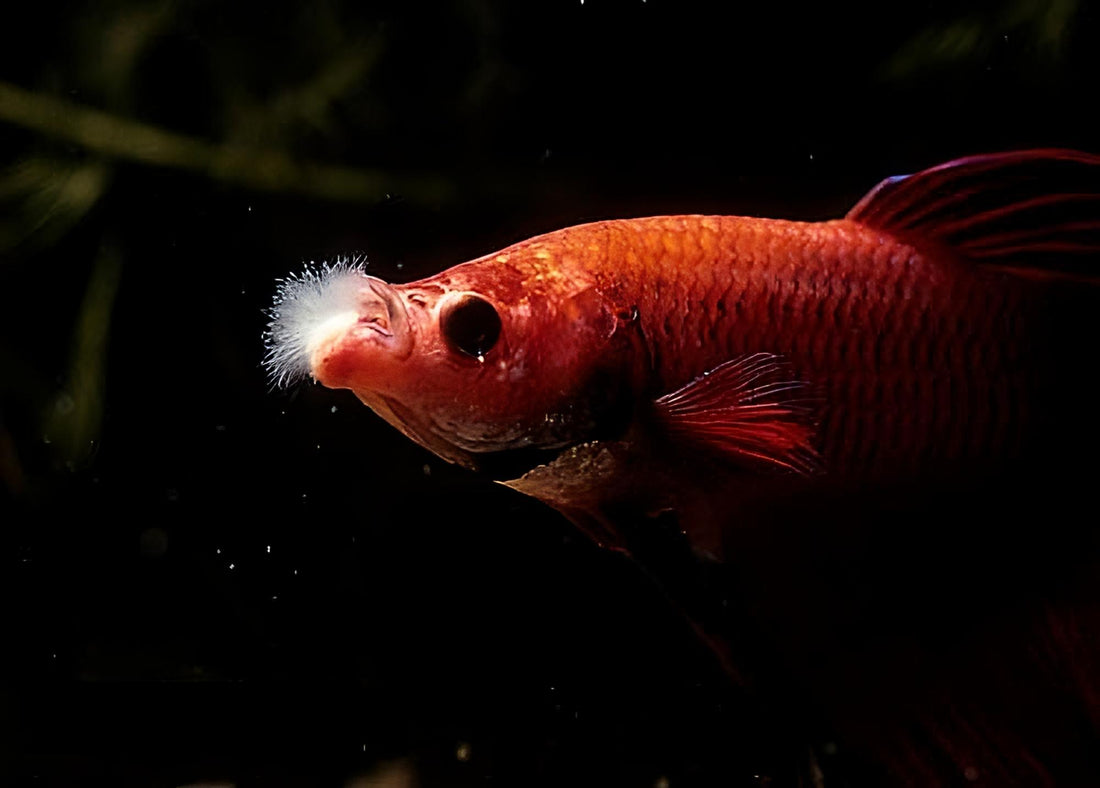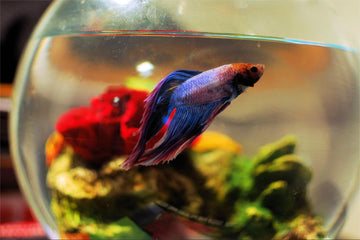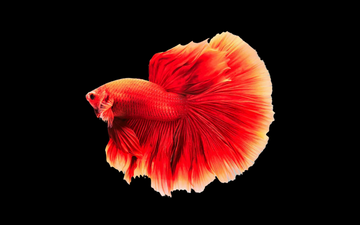11 Common Betta Fish Diseases and How to Treat Them

Contents
Keeping your betta fish healthy can feel like a challenge, especially when they suddenly get sick.
These colorful little fish are prone to different health problems, and if you don’t notice the signs early, things can get worse quickly.
Often, issues like stress or dirty water are to blame, so preventing sickness is just as important as knowing how to treat it.
If your betta starts behaving strangely or looks a little off, it’s best to act fast.
In this guide, we’ll go over the most common health problems bettas face, what causes them, how to recognize the symptoms, and how to help them recover.
1. Fin Rot

Fin rot is a common issue that can affect betta fish, especially when they’re stressed or not living in the best water conditions.
It happens when harmful bacteria get a chance to attack, usually because the fish’s immune system isn’t strong enough. You’ll notice the edges of your betta’s fins and tail starting to look frayed or torn, which can be pretty worrying.
Stress factors like overcrowded tanks, dirty water, and aggressive tank mates can really put your betta at risk for this disease.
If you don’t take care of it quickly, fin rot can get worse, making your fish more susceptible to other problems.
The good news is that keeping an eye on your fish and acting fast can help prevent fin rot from becoming a serious issue.
Symptoms of Fin Rot
- The fins look torn or ragged.
- Fins may lose their bright colors and look faded.
- Red or brown color around the edges of the fins.
- Your fish might become less active and hide more.
- Affected fish often eat less or stop eating altogether.
Treatment for Fin Rot
- Isolate the fish: Move your betta to a separate tank to prevent spreading the infection.
- Use antibiotics or salt treatment: Look for over-the-counter medications specifically for fin rot, like tetracycline or erythromycin. Adding aquarium salt can also help with healing, but make sure to use the right amount and watch how your fish reacts. Just follow the instructions carefully.
- Improve water quality: Clean the tank and do regular water changes. Make sure the water temperature is between 76°F and 82°F (24°C - 28°C).
- Create a calm environment: Add hiding spots and make sure the tank is peaceful to help your betta feel safe.
2. Ich (White Spot Disease)

Ich, or Ichthyophthirius multifiliis, is a common parasite that can infect many freshwater fish, including bettas.
People often call it "white spot disease" because it shows up as tiny, white dots that look like grains of salt on the fish’s body, fins, and gills. These spots can be alarming to see, and if your betta has them, it’s a sign that something's not right.
This parasite spreads quickly, especially in aquariums where the water quality isn't good. Infected fish can become stressed, which makes them more likely to get other health problems.
Ich is pretty common in both home aquariums and fish stores, so it’s important for betta owners to know how to recognize and treat it.
When a betta gets ich, it may not show symptoms right away, but the parasite starts to attack its skin and gills.
If you don’t treat it quickly, the situation can get serious and even lead to death.
Symptoms of Ich
- Small, white, grainy dots on the skin, fins, and gills.
- Fish rubbing against tank decorations to relieve irritation.
- Less activity and more resting.
- Increased gill movement indicates breathing issues.
- Fading colors due to stress or illness.
Treatment for Ich
- Quarantine the infected fish: If you can, move infected fish to a separate tank to prevent spreading ich to healthy fish.
- Raise water temperature: Gradually heat the tank to about 78-80°F (25-27°C) to speed up the parasite's life cycle.
- Use medication: Apply an ich treatment that contains copper or formalin. Just follow the instructions on the package for how much to use. You can also add aquarium salt (about 1 tablespoon for every 5 gallons of water) if it’s safe for your tank.
- UV sterilizers: Using a UV sterilizer can also help to break the cycle of infection and reduce the risk of further outbreaks.
3. Swim Bladder Disease

Swim Bladder Disease is a common problem for betta fish that affects their ability to control their buoyancy.
The swim bladder is a gas-filled organ that helps fish float and stay stable in the water. When it doesn’t work properly, your betta might have trouble swimming or staying at the right level in the tank.
This problem can come from different things, like genetics, dirty water, or a diet that doesn’t suit them.
However, betta fish are especially prone to this condition because of their unique body shape.
Symptoms of Swim Bladder Disease
- Stuck at the top or struggling at the bottom.
- Twitching or swimming in circles.
- Losing interest in food.
- Bloated appearance.
Treatment for Swim Bladder Disease
- Better food: Switch to higher-quality food or pellets. Use sinking or slow-sinking pellets to prevent your betta from taking in too much air.
- Pea: Offering your betta a single cooked pea may help reduce constipation.
- Fasting: Consider fasting your betta for a few days to give its digestive system a break.
- Antibiotics: If a bacterial infection is suspected, use broad-spectrum antibiotics like Erythromycin or Tetracycline.
- Water change: Maintain a clean environment. Regular water changes can help, but be cautious, as not all bettas handle stress well.
4. Dropsy

Dropsy is a serious condition that can affect betta fish, and it usually means something isn’t right with their health.
When a betta has dropsy, its body swells up, making it look bloated.
This swelling can be caused by different issues, like a bacterial infection, problems with their organs, or poor water quality.
When dropsy sets in, fluid builds up in the fish’s body, and its scales might stick out, giving it a “pinecone” look.
This condition is a sign that the fish is under stress or sick, and if you don’t take action quickly, it can be life-threatening.
Symptoms of Dropsy
- Body looks noticeably swollen.
- Scales may stick out, giving a spiky appearance similar to a pine cone.
- Colors may appear faded or less vivid.
- Difficulty staying afloat, often sinking or floating sideways.
Treatment for Dropsy
- Isolation: Since we don’t know exactly what causes dropsy, it’s a good idea to move your betta to a separate quarantine tank.
- Raise temperature: Bettas are from warmer waters, so raising the temperature to around 80-82°F (27-28°C) can really help boost their immune system and speed up healing.
- Use aquarium salt: Giving your betta daily salt baths with API Aquarium Salt can help reduce the swelling. Just dissolve one teaspoon of salt per gallon of water in a separate container and let your betta sit in it for about 15 minutes.
- Use medication: You might want to use antibiotics or anti-parasitic medications to tackle any underlying infections.
5. Popeye

Popeye is a common issue that can affect betta fish, where one or both of their eyes start to swell and stick out.
While it might look a bit scary, it’s not a disease by itself but a sign of something else going on. Usually, it means the fish could have a bacterial infection, poor water quality, or maybe even an injury.
This condition can develop quickly, so spotting it early is really important.
The good news is that with the right care, many bettas can recover from Popeye and continue to thrive.
Symptoms of Popeye
- One or both eyes appear swollen and bulging
- Cloudiness or opacity in the affected eye(s)
- Possible redness around the eye area
- Changes in behavior, like reduced activity or hiding
- Difficulty swimming or navigating the aquarium
Treatment for Popeye
- Improve water quality: Start by changing some of the water to keep things clean. Make sure the temperature and pH levels are stable.
- Isolate the affected fish: Move your betta to a separate tank so it doesn’t spread anything to other fish.
- Use antibiotics: Treat your fish with a broad-spectrum antibiotic, like tetracycline or erythromycin, following the instructions on the package.
6. Velvet Disease

Velvet disease is a serious but common problem for betta fish, caused by tiny parasites called Piscinoodinium.
It’s sometimes confused with ich because both can make your fish look like they’re covered in spots. However, with velvet, the spots usually have a more golden or rust-colored appearance, like the fish has been dusted with a fine powder.
This parasite attacks the skin of the betta, causing a lot of discomfort.
Your fish might start rubbing against things in the tank, like decorations or rocks, trying to scratch the itch.
If left untreated, velvet can get serious very quickly and might even be fatal.
Symptoms of Velvet Disease
- A gold or rusty dust-like appearance on the body, often seen under a light.
- Rubbing against tank decor or substrate.
- Clamped fins (fins held close to the body).
- Loss of appetite.
- Lethargy and spending more time near the bottom of the tank.
Treatment for Velvet Disease
- Isolation: Move your betta to a quarantine tank to prevent the disease from spreading to other fish.
- Darken the tank: Velvet parasites like the light, so keep the tank as dim as possible during treatment to help slow the parasite’s growth.
- Raise the temperature: Bettas are used to warmer water, so gradually increase the tank temperature to around 82-84°F (28-29°C). This will help boost their immune system and can speed up recovery.
- Medications: Anti-parasitic treatments like copper-based medications (e.g., Seachem Cupramine) are effective in killing the velvet parasites. Be sure to follow dosing instructions carefully to avoid overdosing.
7. Columnaris

Columnaris is a common bacterial infection that betta fish can get, and it’s often confused with a fungal infection because of the way it looks.
This disease is usually caused by stress, poor water quality, or overcrowded tanks, and it can spread pretty fast if it’s not treated right away.
The bacteria responsible, Flavobacterium columnare, can attack the fish's skin, mouth, or gills, creating fluffy, cotton-like patches.
If left untreated, Columnaris can lead to severe damage, with catching it early gives your betta the best chance of recovery.
Symptoms of Columnaris
- White or grayish cotton-like patches on the skin, fins, or mouth.
- Fraying or decaying of the fins.
- Ulcers or open sores on the body.
- Difficulty breathing, especially if the gills are affected.
- Lethargy and loss of appetite.
Treatment for Columnaris
- Isolation: As soon as you spot signs of Columnaris, move your betta to a separate tank to stop the infection from spreading to other fish.
- Water quality: Since dirty water makes this infection worse, do frequent water changes and make sure the tank stays clean. Lowering the temperature to about 75°F (24°C) can also help slow down the bacteria's growth.
- Antibiotics: Use medications like Kanaplex or Furan-2, which are designed to fight bacterial infections. Follow the instructions closely to make sure the treatment is effective.
- Salt baths: Giving your betta short salt baths can help ease the symptoms and support healing. Dissolve one teaspoon of aquarium salt per gallon of water, and let your fish soak for 10-15 minutes each day.
8. Gill Flukes

Gill flukes are tiny parasitic flatworms that attach themselves to the gills of betta fish, causing irritation and breathing problems.
These pests can really mess up your fish’s health if not caught early. They usually get into the tank through contaminated water, new fish, or live plants that carry the parasites.
Once they’re in, they can spread fast and cause major stress to your betta.
When your betta has gill flukes, they might start rubbing their body against things in the tank, like rocks or decorations, as if trying to scratch an itch.
Breathing also becomes harder for the fish, and they may start gasping at the surface of the water or hanging out near the filter where oxygen levels are higher.
If you don’t treat gill flukes quickly, they can lead to more serious infections and make your betta even sicker.
Symptoms of Gill Flukes
- Gasping for air at the surface or near the filter output.
- Scratching or rubbing against objects in the tank.
- Red or inflamed gills, often producing mucus.
- Lethargic behavior, staying still more often than usual.
- Loss of appetite and refusing food.
Treatment for Gill Flukes
- Isolation: Move your betta to a separate tank to stop the infection from spreading to other fish.
- Improve oxygen levels: You can add an air stone or reduce the water level in the quarantine tank to help your betta breathe easier.
- Use anti-parasitic medication: Medications like Praziquantel are effective at killing gill flukes. Follow the instructions carefully for dosing and treatment length.
- Aquarium salt bath: A salt bath can help relieve your fish’s discomfort. Dissolve one teaspoon of aquarium salt per gallon of water, and let your betta sit in it for about 10-15 minutes. This will soothe the gills and reduce inflammation.
- Clean the main tank: While your betta is in quarantine, give the main tank a deep clean, including decorations and filters, to prevent the flukes from returning once your fish is back in.
9. Anchor Worms

Anchor worms are nasty little parasites that latch onto the fish’s body and burrow under the skin, causing a lot of discomfort and irritation.
They look like long, thread-like worms, and you can usually spot them hanging from the fish’s fins, tail, or body. You might even see them hanging off your betta, especially around the fins or body, which can look pretty alarming.
If not treated quickly, anchor worms can create open sores that can easily get infected, making things even worse for your fish.
They’re particularly harmful because they weaken your betta’s immune system, leaving it more vulnerable to other illnesses.
Symptoms of Anchor Worms
- Visible thread-like worms protruding from the fish’s body or fins.
- Red, inflamed areas around where the worms are attached.
- Open sores or ulcers on the fish's body.
- Betta rubbing against objects in the tank, trying to dislodge the worms.
- Decreased appetite and sluggish behavior.
Treatment for Anchor Worms
- Manual removal: If the anchor worms are large enough to see, you can gently remove them with tweezers. Hold the betta carefully, and after pulling out the worm, clean the area with an antiseptic to prevent infections from developing in the open sores.
- Quarantine tank: Move your betta to a separate quarantine tank to stop the parasites from spreading to other fish in the tank.
- Salt baths: Give your betta a salt bath using aquarium salt. Dissolve one teaspoon of salt per gallon of water in a separate container and let your betta soak in it for about 15 minutes.
- Medications: Treat the tank with anti-parasitic medications, such as API General Cure or similar products designed to target anchor worms. This helps kill the parasites and prevent further infestations.
10. Hole in The Head Disease

Hole in The Head Disease, also called Head and Lateral Line Erosion (HLLE), is a condition that shows up as small pits or holes on your betta's head, especially around the eyes and along their lateral line.
It’s often a result of poor water quality, bad nutrition, or sometimes even stress. Parasites and bacteria can also contribute to this issue.
If you don't catch it early, these tiny pits can grow deeper and lead to infections, making things even worse for your betta.
Symptoms of Hole in The Head Disease
- Small pits or holes appear on the fish's head, around the eyes, or lateral line.
- Loss of color in the affected areas.
- Fish may become lethargic or lose their appetite.
- Dark vertical lines may appear on the body.
Treatment for Hole in The Head Disease
- Better water conditions: The number one thing to focus on is water quality. Poor water conditions are a big reason fish get this disease. Make sure your betta’s water is clean and change it regularly. A properly working filter and keeping things like ammonia and pH levels in check are super important.
- Balanced diet: Sometimes Hole in The Head Disease happens when your betta isn’t getting enough nutrients. A healthy, varied diet with high-quality betta pellets, live or frozen foods like bloodworms, and foods rich in vitamins, especially vitamin C, can help them heal and stay strong.
- Medication: If the holes have already appeared, you might need to use anti-parasitic or antibacterial medications. Anti-parasitic treatments or antibiotics, like Seachem’s MetroPlex, can help clear up any infections or parasites causing the issue.
11. Hemorrhagic Septicemia

Hemorrhagic septicemia is a dangerous bacterial infection that can strike betta fish and is often deadly if not treated quickly.
This disease causes internal bleeding, which can show up as red streaks or spots on the fish's body and fins.
It usually enters through the water, especially in tanks with poor water quality, or when a fish is already stressed or weakened.
Once a betta gets this disease, the bacteria attack the fish’s blood vessels, causing bleeding and damaging their internal organs.
The infection can spread quickly, and without treatment, it can take down your betta in a matter of days.
Hemorrhagic septicemia is definitely something you don’t want to ignore.
Symptoms of Hemorrhagic Septicemia
- Red streaks or spots on the body, fins, or eyes.
- Swollen or bloated body, particularly around the belly area.
- Struggle to breathe.
- Clamped fins and unusual behavior, such as staying near the surface.
Treatment for Hemorrhagic Septicemia
- Isolate your fish: First thing’s first, move your betta to a separate quarantine tank. This helps prevent the disease from spreading to any other fish in the main tank.
- Antibiotics: You’ll need to treat your betta with a broad-spectrum antibiotic like Kanamycin or Maracyn-Two. These medications are designed to fight off the bacteria causing the infection.
- Improve water conditions: A big part of treating hemorrhagic septicemia is keeping your tank’s water clean. Make sure you’re doing regular water changes and using a water conditioner to neutralize harmful bacteria.
- Reduce stress: Stress can make your betta more likely to get sick in the first place. Avoid overcrowding the tank and keep the water temperature stable – bettas are happiest in warm water around 78-80°F (25-27°C).
Keep Your Betta Healthy from the Start
Caring for a betta is much easier when you can catch health issues early and know how to treat them. But the best way to avoid problems is by starting with a healthy betta in the first place.
At Tropicflow, our bettas are raised with attention and care, so you can trust you’re getting a strong, well-cared-for fish.

When you choose Tropicflow, you’re not just getting a beautiful betta for your tank—you’re getting peace of mind, knowing they’re in good shape and ready to settle into their new home.
Looking for a new betta or tips to keep yours healthy? Tropicflow is here to help!
No comments











0 comments